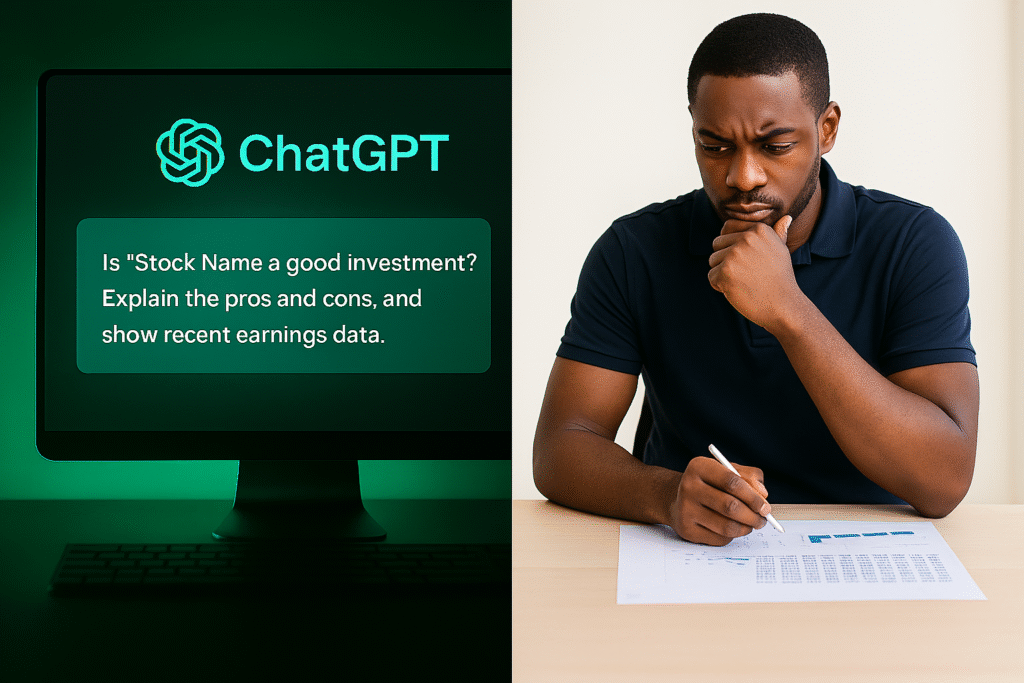Using AI for Investing? Here’s How to Double-Check Its Advice

AI is a powerful but it can also be confidently wrong. If you’re blindly trusting ChatGPT (or any AI) to guide your trades, you’re playing a dangerous game.
Before we get into the risks, if you’re just starting to explore AI for investing, check out my earlier article: How to Use ChatGPT to Become a Better Investor. It lays the groundwork for using AI tools the right way, especially if you’re still building confidence.
Common Pitfalls of AI
Even with the right intentions, it’s easy to misstep when using AI for investing. From vague prompts to over reliance on surface-level answers, here are a few traps to avoid before you start acting on advice.
• Outdated or incorrect data – AI tools like ChatGPT don’t provide real-time market data. They’re fantastic for research, strategy and breaking down complex subjects but not for making split second decisions. If you’re day trading or chasing market moves relying solely on AI could backfire.
• Generic or overconfident tone – If you don’t prompt well, you’ll get vague or overly confident advice. AI tools tend to sound authoritative, even when they’re wrong. They also lean towards being agreeable, which can lead to confirmation bias. Don’t just ask for analysis challenge your own thesis when using AI.
• No citations or source transparency – This is important. When it comes to financial data, always ask where the numbers came from. If ChatGPT can’t cite a source or provide context, don’t trust the data at face value. (Also, does AI have a backside? Because sometimes it pulls numbers straight out of it.)
Vetting Checklist

So how do you avoid falling into those traps? Here’s a quick checklist you can use every time you get stock advice from ChatGPT or any AI tool.
- Ask for sources – Prompt with “Cite your sources” or “Where is this data from?”
- Cross-check with real data – Use sites like Yahoo Finance, Finviz, or company filings.
- Use your brain – If it sounds too good to be true…it probably is.
- Layer in multiple prompts – Don’t stop at one answer. Re-frame the question. Ask again. Pressure test the logic.
Smart Followup Questions/Prompts to Ask AI
Once you’ve done that basic vetting, you can dig deeper by asking smarter, more targeted questions. These follow-ups can turn a good AI answer into a great one and give you the confidence to act or walk away.
- What are the risks of this investment?
- What do bearish analysts say about this stock?
- Compare this stock to 2 others in the same sector and give a side-by-side breakdown.
- Summarize the last 4 earnings reports? Highlight key revenue and margin trends.
- Assess the company’s balance sheet. Are there any red flags in debt, cash flow, or liquidity?
- What macroeconomic factors (interest rates, tariffs, consumer trends, etc.) could impact this stock?
- Does this company pay dividends? If so, are they stable based on payout ratio and cash flow?
Bottom Line
ChatGPT is a research assistant, not a crystal ball. Use it to speed up your due diligence, pressure test your ideas, and surface new opportunities but always verify before acting on any advice. The best investors use tools to get smarter, not to shortcut the process.
Want more tips on how to use ChatGPT the Right Way?
Subscribe below and download my free eBook, Learn How to Invest with ChatGPT, which includes an entire chapter on what to watch out for and how to avoid common mistakes.